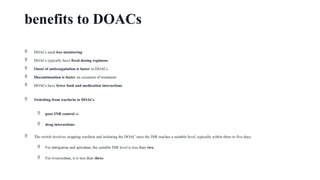BENEFITS OF DIRECT ORAL ANTICOAGULATIONS
- 1. DOAC
- 2. benefits to DOACs ? DOACs need less monitoring ? DOACs typically have fixed dosing regimens ? Onset of anticoagulation is faster in DOACs ? Discontinuation is faster on cessation of treatment ? DOACs have fewer food and medication interactions ? Switching from warfarin to DOACs ? poor INR control or ? drug interactions. ? The switch involves stopping warfarin and initiating the DOAC once the INR reaches a suitable level, typically within three to five days. ? For dabigatran and apixaban, the suitable INR level is less than two, ? For rivaroxaban, it is less than three.
- 3. Anticoagulation and surgery ? DOACs are typically stopped at least 24 hours preoperatively in procedures with lower bleed risk and at least 48 hours preoperatively in procedures with higher bleed risk.10 ? Warfarin may require cessation up to 5 days before surgery to allow for INR normalisation.6 Oral phytomenadione administration is considered if the INR is above 1.5 before surgery.2,6 ? In cases where immediate cessation of anticoagulation poses a high thrombotic risk, such as in patients with mechanical heart valves or atrial fibrillation, bridging therapy with a heparin may be considered. A heparin is temporarily substituted for the oral anticoagulant to maintain therapeutic anticoagulation during the peri- operative period. It is typically discontinued 24 hours before surgery to minimise the bleeding risk.15 ?


